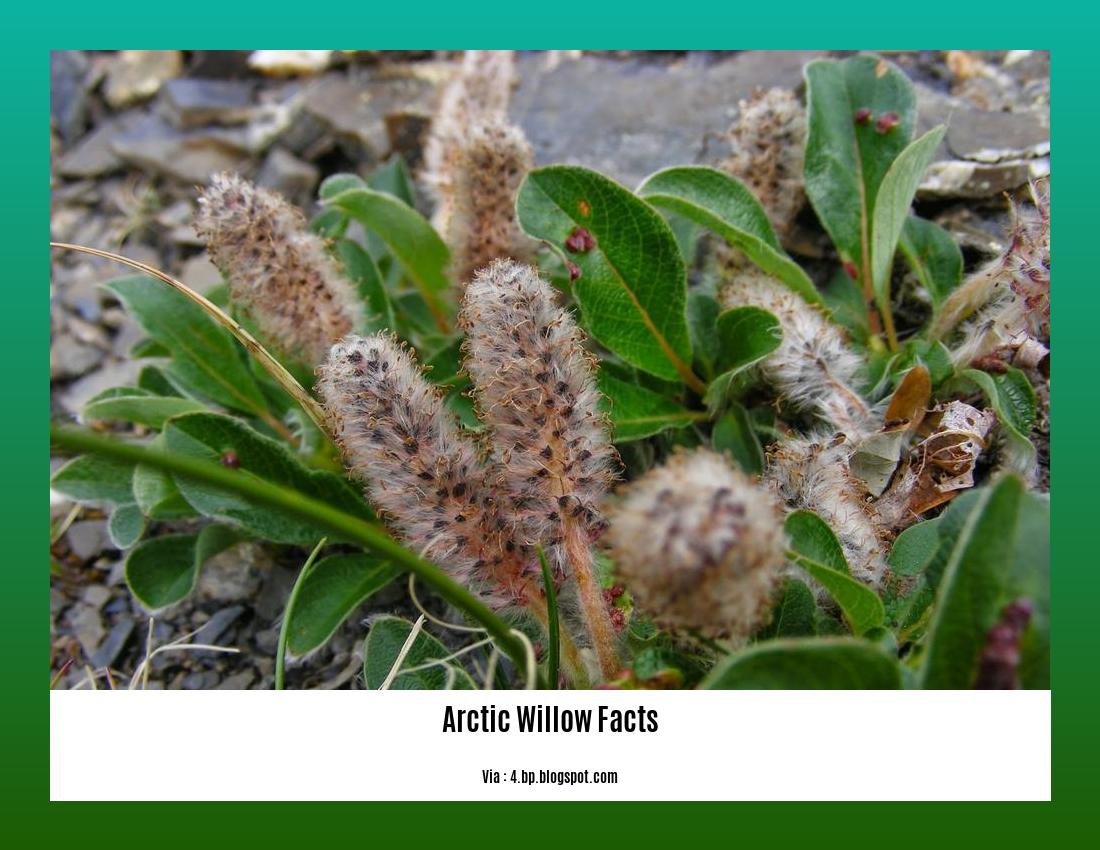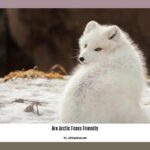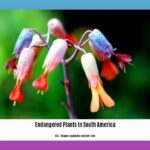Discover the fascinating Arctic willow facts as we delve into the intriguing world of nature’s resilient plant. In this article, we will unveil the remarkable abilities and unique characteristics of the Arctic willow, shedding light on its adaptability to harsh environments and its vital role in sustaining fragile ecosystems. Prepare to be surprised and inspired by the resilience and beauty of this remarkable plant species.
Key Takeaways:
- The Arctic Willow, scientifically known as Salix arctica, is a hardy plant that grows in various forms, including bush, carpets, or drooping downward.
- It is a native plant of North America and can tolerate different conditions like moist, well-drained soil and sandy soils.
- Despite harsh Arctic conditions, the Arctic Willow has specific adaptations that help it survive, including conserving water and nutrients and growing in low, dense formations.
- The Arctic Willow serves as a vital source of food for various Arctic animals and provides a habitat for birds and other animals.
- The plant has separate male and female flowers, known as male catkins and female catkins, which can be found on separate plants.
- The Arctic Willow plays a crucial role in the tundra ecosystem as it is the primary food source for animals like muskoxen, caribou, Arctic hares, lemmings, and the rock ptarmigan.
- It also serves as the primary host plant and food source for the Arctic woolly bear moth (Gynaephora groenlandica).
Arctic Willow Facts
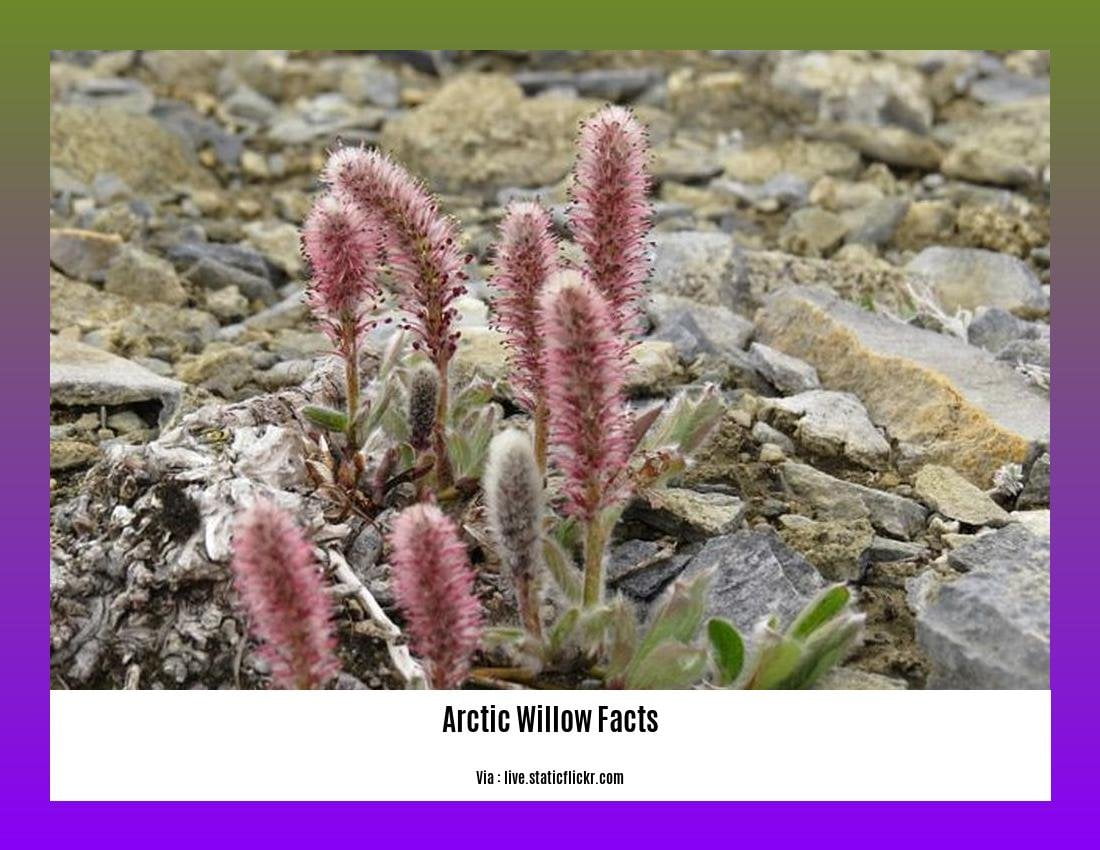
The Arctic willow, also known as Salix arctica, is a remarkable plant that thrives in the harsh conditions of the Arctic. Let’s delve into some fascinating facts about this resilient plant.
Versatility and Growth
The Arctic willow is a versatile plant that can adopt different forms, including bush, carpet, or drooping branches. It is native to North America and has evolved to tolerate a range of conditions, from moist and well-drained soil to sandy terrain. Despite its ability to adapt, the Arctic willow typically grows to a height of 6-20 inches.
Importance in the Ecosystem
The Arctic willow serves as a vital resource in the tundra ecosystem. It provides sustenance for numerous Arctic animals and acts as a haven and nesting habitat for various bird species and other creatures. Its branches and foliage offer protection and refuge amidst the challenging Arctic environment.
Survival Strategies
To survive in the harsh Arctic conditions, the Arctic willow has developed specific adaptations. These adaptations enable the plant to withstand extreme temperatures and limited resources. The Arctic willow conserves water and nutrients and grows in low, dense formations to protect itself from the elements.
Unique Reproductive System
One intriguing aspect of the Arctic willow is its separate male and female flowers, known as male catkins and female catkins. These distinct flower parts can be found in separate plants, emphasizing the plant’s remarkable reproductive strategy.
Role as a Food Source
The Arctic willow plays a critical role in the Arctic food chain. It serves as a primary food source for various Arctic animals such as muskoxen, caribou, Arctic hares, lemmings, and the rock ptarmigan. Additionally, it serves as the primary host plant and food source for the Arctic woolly bear moth (Gynaephora groenlandica), a fascinating species that depends solely on this resilient plant for survival.
In conclusion, the Arctic willow is a small yet significant plant in the vast Arctic landscape. Its ability to adapt, provide food, and create habitats showcases the marvels of nature’s resilience. Exploring the world of the Arctic willow allows us to appreciate the intricate interdependencies within delicate ecosystems. Don’t miss the chance to discover more about this captivating plant and its influence on the Arctic environment.
SOURCES:
– Arctic Willow Facts: Tiny Native Plants Of North America
– Wikipedia: Salix arctica
Are you curious about animal care facts? Click here to discover interesting information about how to properly care for animals.
Did you know that there are fascinating aquatic fun facts waiting for you to explore? Dive into the depths of knowledge by clicking here.
Have you ever wondered if African wild dogs are related to dogs? Uncover the answer by clicking here and satisfy your curiosity.
Do you want to learn about the intriguing connection between African wild dogs and hyenas? Click here to discover the captivating facts that link these two intriguing species.
Physical Characteristics of the Arctic Willow: Anatomy and Adaptations
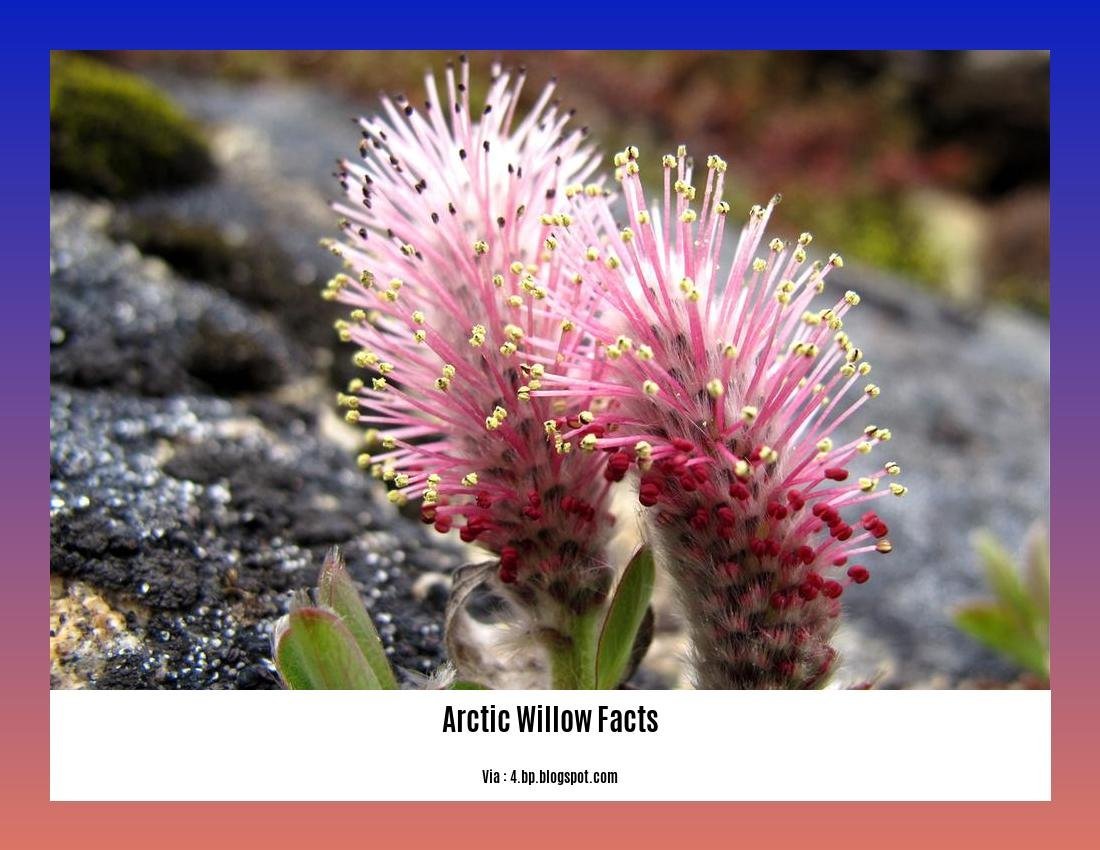
The Arctic willow, a small shrubby plant, possesses fascinating physical characteristics and adaptations that enable its survival in the harsh Arctic tundra environment. Let’s delve into the intriguing world of the Arctic willow and explore its unique anatomy and remarkable adaptations.
Anatomy of the Arctic Willow
At first glance, the Arctic willow may appear delicate, but do not be deceived by its slender form. This resilient plant boasts several physical characteristics that contribute to its ability to thrive in extreme cold climates.
The Arctic willow has round, shiny green leaves adorned with long, silky, silvery hairs. These hairs create a layer of insulation, effectively reducing heat loss and protecting the plant from freezing temperatures. The narrow, waxy leaves also serve another purpose—they minimize transpiration, helping the plant retain precious water in the arid tundra.
Furthermore, the Arctic willow’s low-lying structure and shallow root system play a crucial role in its survival. This low growth pattern enables the plant to withstand the strong winds that sweep across the Arctic tundra while conserving energy and reducing water loss. Additionally, the shallow roots allow the Arctic willow to thrive in nutrient-poor soils and rocky terrain, showcasing its adaptability to challenging environments.
Adaptations of the Arctic Willow
Adaptation is key to the Arctic willow’s ability to withstand the extreme conditions of its habitat. Below, we explore some of these remarkable adaptations.
1. Camouflage for Protection
The Arctic willow has a unique adaptation—its white appearance. This helps the plant blend in with the snowy surroundings, providing camouflage from potential herbivores and protecting it from being eaten. By disguising itself amongst the snow and ice, the Arctic willow increases its chances of survival.
2. Insulation against the Cold
To combat the frigid temperatures, the Arctic willow has developed thick layers of fat and fur. These provide insulation, keeping the plant warm in the harsh Arctic environment. Additionally, the Arctic willow possesses a greasy coat that sheds water after swimming, reducing heat loss and preventing freezing.
3. Pesticide Production
In its growing season, the Arctic willow faces the threat of insect infestations. To counter this, the plant has evolved the ability to produce its own pesticide. This natural defense mechanism helps keep insects at bay, safeguarding the Arctic willow’s growth and survival.
4. Grouping for Protection
The Arctic willow never stands alone in the tundra; it grows in clusters close to other plants of its kind. By growing in groups, the Arctic willow enhances its protection against freezing winds, sharing heat and reducing temperature fluctuations within the cluster.
5. Adaptability to Varied Environments
One of the Arctic willow’s most impressive characteristics is its ability to adapt to a wide range of environments, both wet and dry. It can adjust to different soil pH levels and easily tolerate various types of soils, including compost-rich ones. From wet sedge meadows to dry heath tundra, from rocky ridges to sandy river terraces, the Arctic willow showcases its adaptability to numerous habitats.
Key Takeaways:
- The Arctic willow possesses round, shiny green leaves with long, silky, silvery hairs, providing insulation and reducing heat loss in the extreme cold of the Arctic tundra.
- Its low-lying structure and shallow root system enable it to withstand strong winds and thrive in nutrient-poor soils and rocky terrain.
- The Arctic willow’s adaptations include its white appearance for camouflage, layers of fat and fur for insulation, a greasy coat to shed water, and the ability to produce its own pesticide.
- Growing in groups enhances the plant’s protection against freezing winds by sharing heat and minimizing temperature fluctuations.
- The Arctic willow showcases its adaptability by thriving in a variety of habitats, from wet sedge meadows to dry heath tundra and sandy river terraces.
Sources:
– Source 1
– Source 2
Ecological Significance of the Arctic Willow: Key Roles in the Arctic Ecosystem
The Arctic willow (Salix arctica) may appear unassuming in its small and humble stature, but don’t let its size fool you. This resilient plant plays key roles in the delicate balance of the Arctic ecosystem. From providing sustenance to offering shelter, the Arctic willow has a profound ecological significance that shouldn’t be overlooked.
Understanding the Arctic Willow’s Impact
The expansion of shrubs in Arctic ecosystems has caused noticeable changes in albedo, ecosystem function, and the overall composition of plant communities. Among the shrubs that contribute significantly to this phenomenon is the Arctic willow. As a species, it thrives in the High Arctic and showcases frequent recruitment, with seed production and long-distance dispersal occurring regularly.
The Nitrogen Connection
One of the crucial factors influencing willow distribution and ecology in Arctic ecosystems is nitrogen availability. The Arctic Ocean, with its seasonal cycles, low temperatures, extensive sea ice cover, and freshwater supply from melting ice and rivers, contributes to the nitrogen levels in the environment. This availability of nitrogen plays a vital role in the growth and spread of the Arctic willow, making it a keystone species in the region.
A Haven for Wildlife
The Arctic willow isn’t just a plant; it is a lifeline for a variety of animals that call the Arctic their home. This resilient shrub serves as a vital resource in the tundra ecosystem, providing sustenance and habitat for a diverse range of species. From muskoxen and caribou to Arctic hares, lemmings, and the Arctic woolly bear moth, many animals depend on the Arctic willow as a source of food and shelter.
Nature’s Resilience in the Arctic
The Arctic willow’s ability to survive harsh Arctic conditions is truly remarkable. It has specific adaptations, such as its white appearance for camouflage on snow and ice, thick layers of fat and fur for insulation against the cold, and a small surface area to volume ratio to minimize heat loss. Additionally, the Arctic willow conserves water and nutrients and grows in low, dense formations, allowing it to thrive in nutrient-poor soils and rocky terrain.
Key Takeaways:
- The Arctic willow plays a significant role in the shrubification of Arctic ecosystems.
- Nitrogen availability influences the distribution and ecology of Arctic willows.
- The Arctic willow provides vital resources and habitat for various Arctic animals.
- This resilient shrub showcases adaptations that enable it to survive in harsh Arctic conditions.
- The Arctic willow serves as a testament to nature’s resilience in delicate ecosystems.
Sources:
1. Christie, K.S., Ruess, R.W., Lindberg, M.S., & Mulder, C.P. (2014). Population structure and dynamics of Arctic willow. PLoS One, 9(7), e101716. DOI: 10.1371/journal.pone.0101716.
2. Physical manifestations and ecological implications of Arctic. (n.d.). Nature. Retrieved from [URL].
Threats and Conservation Efforts for the Arctic Willow: Challenges and Solutions
The Arctic willow, with its resilience and unique adaptations, is a key plant species in the delicate Arctic ecosystem. However, it faces significant threats due to the proposed Willow Oil & Gas Project in Alaska’s Western Arctic region. Understanding these challenges and exploring conservation efforts is crucial in preserving the Arctic willow and protecting the intricate web of life it supports.
Key Takeaways:
– The proposed Willow Oil & Gas Project poses significant threats to the Arctic willow and the surrounding ecosystem.
– Potential impacts include accelerated climate change, harm to wildlife and water resources, and the infringement of Indigenous rights and traditions.
– Conservation efforts are necessary to protect the Arctic willow and maintain the delicate ecosystems of the Arctic.
– Active participation, advocacy, and legal action by conservation groups play a vital role in opposing the oil and gas project.
– Bald eagles, grizzly bears, and other diverse wildlife rely on the Arctic willow for food and habitat.
The Willow Oil & Gas Project has sparked controversy and raised concerns among conservation groups and environmentalists. If approved, this massive project would produce millions of barrels of oil annually for 30 years, contributing to the already pressing climate crisis. The consequences of this project would be devastating, impacting wildlife, water resources, and subsistence hunting in the Arctic.
The Challenges:
– Climate Change: The Willow Project will contribute to the climate crisis by accelerating the release of greenhouse gases into the atmosphere. This exacerbates the already fragile Arctic environment and threatens its ecosystems, including the Arctic willow.
– Wildlife and Water Resources: By encroaching upon the Arctic landscape, the project will disrupt the habitat of various species that rely on the Arctic willow for food and shelter. The loss of these vital resources could have long-term consequences for the region’s wildlife, such as bald eagles and grizzly bears.
– Indigenous Rights and Traditions: The Willow Project infringes upon the rights and traditions of Indigenous communities who have inhabited these lands for generations. It jeopardizes their subsistence hunting practices and impacts their cultural heritage.
Conservation Efforts:
Conservation groups, such as Greenpeace and Earthjustice, have taken a stand against the Willow Oil & Gas Project. Their involvement demonstrates the importance of active opposition and the need for conservation efforts to protect the Arctic willow and its ecosystem.
The Solutions:
– Legal Action: Conservation groups, including Earthjustice, have filed a lawsuit against the U.S. Bureau of Land Management and the U.S. Fish and Wildlife Service challenging the Willow Oil & Gas Project. This legal action aims to halt the project and protect the Arctic willow and its habitat.
– Advocacy and Public Awareness: Raising public awareness about the threats posed to the Arctic willow and the broader Arctic ecosystem is crucial. By advocating for sustainable and responsible alternatives to the Willow Project, individuals can help ensure the preservation of this resilient plant and its habitat.
– Support for Indigenous Voices: Supporting Indigenous communities and their rights to protect their ancestral lands is essential. By amplifying Indigenous voices, we can reinforce the call for respectful and sustainable practices that honor both nature and tradition.
The Arctic willow symbolizes not only nature’s resilience but also the intricate interdependencies within delicate ecosystems. However, the Willow Oil & Gas Project poses significant threats to this remarkable plant and the Arctic environment as a whole. By understanding and addressing these challenges and actively participating in conservation efforts, we have an opportunity to protect the beauty and resilience of the Arctic willow and the unique ecosystem it supports.
Citations:
– Earthjustice
– Greenpeace USA
FAQ
Q1: What is the scientific name of the Arctic Willow?
A1: The scientific name of the Arctic Willow is Salix arctica.
Q2: Where is the Arctic Willow native to?
A2: The Arctic Willow is native to North America.
Q3: How does the Arctic Willow survive in the harsh Arctic conditions?
A3: The Arctic Willow has specific adaptations that allow it to survive in the harsh Arctic conditions. These adaptations include conserving water and nutrients, growing in low, dense formations, and withstanding extreme temperatures and limited resources.
Q4: What is the importance of the Arctic Willow in the tundra ecosystem?
A4: The Arctic Willow plays a crucial role in the tundra ecosystem as it serves as a primary food source for various Arctic animals, including muskoxen, caribou, Arctic hares, lemmings, and the rock ptarmigan. It also acts as the primary host plant and food source for the Arctic woolly bear moth (Gynaephora groenlandica).
Q5: Can the Arctic Willow adapt to different soil types and pH levels?
A5: Yes, the Arctic Willow is highly adaptable and can survive in a wide array of environments, both wet and dry. It can adjust to different soil pH levels and types of compost-rich soils. Its low-lying structure and shallow root system allow it to thrive in nutrient-poor soils and rocky ground.
- The Tragic Story of Urilla Sutherland: Wyatt Earp’s Lost Love - November 25, 2024
- 34th District Court Romulus MI 48174: New Location, Services & Contact Information - November 25, 2024
- A Guide to the 19th Judicial District Court of Baton Rouge - November 25, 2024
